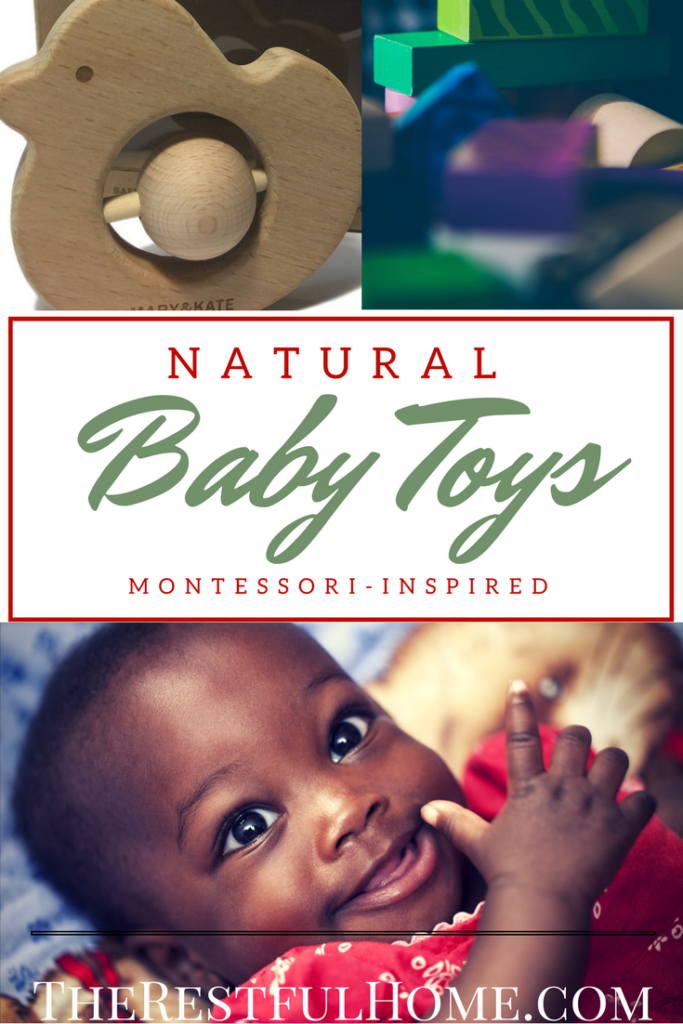 The only things we have bought so far for Baby J to play with are bilingual board books. The rest of his toys and books have been given to us. Some things are keepers for the next baby; other items I’ll let him enjoy for a while and then find a new home for. As I’ve been researching Montessori and Waldorf preschool/babyhood philosophies, I’ve also found natural baby toys I absolutely love. (Plus a few that will help Baby J with his motor skills.) Why natural, meaning wood and cloth when possible? I’m not enthusiastic about companies (yes, that includes you, Sesame Street) imprinting their brands on my child as soon as he opens his little eyes. Also, many plastics may contain harmful materials, to which teething babies are especially susceptible since they chew and suck on everything.
The only things we have bought so far for Baby J to play with are bilingual board books. The rest of his toys and books have been given to us. Some things are keepers for the next baby; other items I’ll let him enjoy for a while and then find a new home for. As I’ve been researching Montessori and Waldorf preschool/babyhood philosophies, I’ve also found natural baby toys I absolutely love. (Plus a few that will help Baby J with his motor skills.) Why natural, meaning wood and cloth when possible? I’m not enthusiastic about companies (yes, that includes you, Sesame Street) imprinting their brands on my child as soon as he opens his little eyes. Also, many plastics may contain harmful materials, to which teething babies are especially susceptible since they chew and suck on everything.
What do I mean by “Natural Baby Toys?”
*No reference to any television programs imprinted on the toy.
First, I’m attempting to keep J from seeing television at all. This can be difficult if David and I are in the middle of our movie when Baby J wakes up and needs attention. However, for the most part, we’ve been able to keep him occupied with turning pages in his board books, army crawling toward our water glasses, chewing on our coffee table’s legs, and turning over his baskets.
Too much time in front of the television has been connected to shorter attention spans (because TV is always changing and flashing), obesity, and aggression. Of course, heredity and parental controls (or lack thereof) also play a role, but, for the most part, people have agreed that parking your child by the TV for a couple of hours a day is a mistake. In fact, the American Academy of Pediatrics recommends that children under 18 months old not be allowed any screen time other than video chatting. (I’m glad they remembered those of us who need to be able to communicate with a traveling spouse/daddy.)
Here are some of their guidelines:
- For children younger than 18 months, avoid use of screen media other than video-chatting. Parents of children 18 to 24 months of age who want to introduce digital media should choose high-quality programming, and watch it with their children to help them understand what they’re seeing.
- For children ages 2 to 5 years, limit screen use to 1 hour per day of high-quality programs. Parents should co-view media with children to help them understand what they are seeing and apply it to the world around them.
- For children ages 6 and older, place consistent limits on the time spent using media, and the types of media, and make sure media does not take the place of adequate sleep, physical activity and other behaviors essential to health.
- Designate media-free times together, such as dinner or driving, as well as media-free locations at home, such as bedrooms.
I would argue that using many toys, coloring books, etc. with pictures of television characters will create in your child a desire to know more about the characters. (Especially if you occasionally turn the TV on so he knows to relate the toy with the TV. Baby J won’t have that…advantage? We don’t have a television.) In addition, many of the television-inspired toys have what I call a “commercial” look about them. When most of your toys are bright red/orange/whatever, plastic, make noises because they have batteries, etc. you are looking forward to a life of confusion and chaos. I now understand why my father took the batteries out of all our toys.
*May be a household implement.
I often let Baby J play with an extra set of measuring spoons and a little bowl so he can “cook with Mommy.” A simple wooden spoon is the perfect toy for a little one following you around in the kitchen. Or stick a cup in the bathtub with him and let him pour water over himself. Playtime doesn’t have to be complicated.
* May be something from the outdoors.
When Baby J is older, we will make a rock collection together, leaf collections, etc. Now, since everything automatically goes into his mouth, I have to be careful to choose things for him to play with that are both clean and too large to get shoved down his throat.
*May be a Montessori-inspired learning puzzle or stacking toy, preferably made from wood.
Why use a learning puzzle? Putting a puzzle together requires small, careful movements (fine motor skills and hand-eye coordination). If the puzzle is self-correcting, a child will be able to figure out what goes where from a very young age. Larger stacking toys help build gross motor skills. Read more about why puzzles are good for your child’s development in this article.
*May be made from natural materials, like wood or cotton.
(However, I wouldn’t discount something just because it isn’t Waldorf-approved.)
Wondering what a Montessori-Inspired Toy would look like? Here are just a few examples of Montessori-Inspired Natural Baby Toys (not all natural, but for the most part). Click on the pictures or links below to be taken to the Amazon listing for these products.
Teethers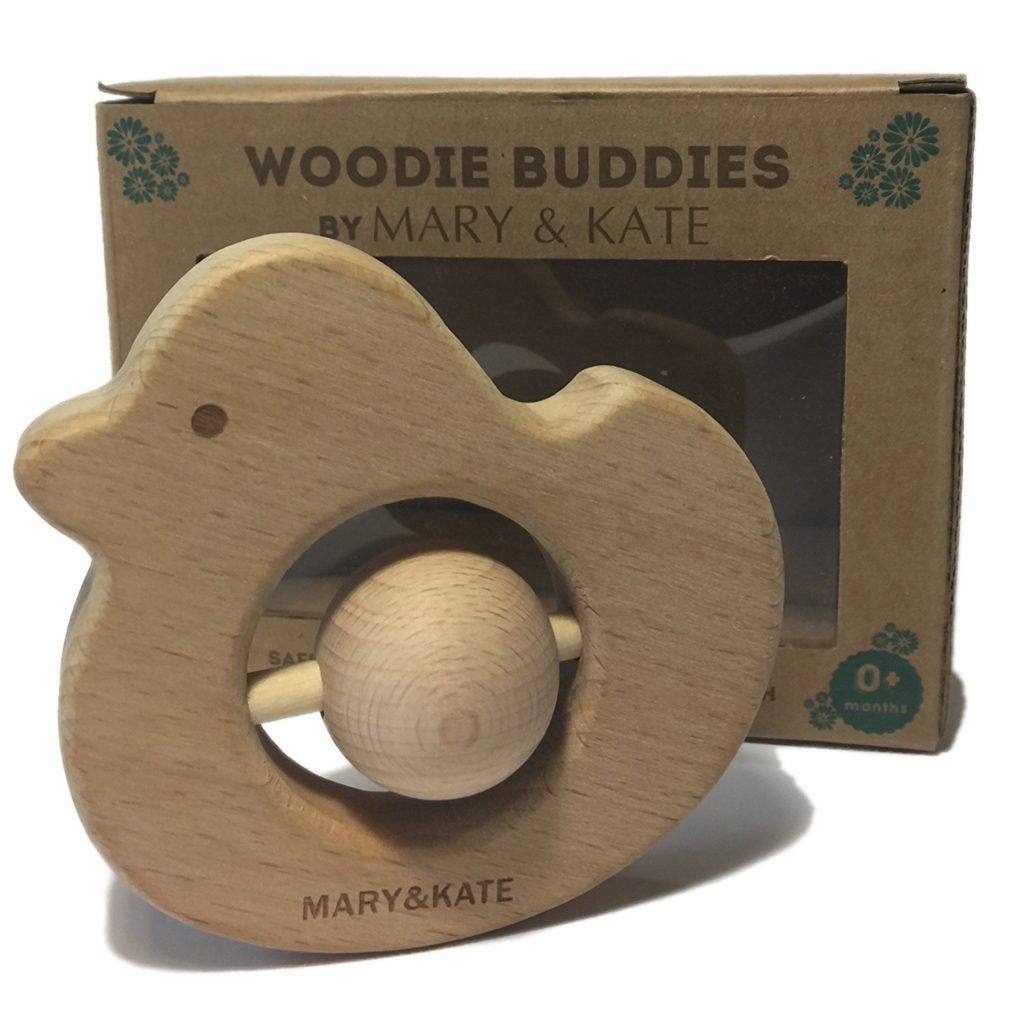
*Baby J already loves to chew on anything wood he can sink his teeth into. This duckie would be so much more portable than our coffee table. Their whale is just as cute.
*Check out this adorable hedgehog wooden chew toy. I really want to make one similar to this, but I’m not sure I could make the hedgehog. (Are cute features like that for Baby or actually more for the parents?)
*This plush teething doll (and the bunny-ears teether by the same company that you see when you click this link) is Waldorf-inspired. (Have you read my article comparing Montessori and Waldorf philosophies yet?) You can tell not only by the product description but by the simplicity of the doll, especially in its facial features.
Musical
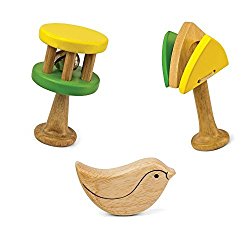 *I think these little rattles/handbells shown in the picture at right are adorable. The little bird is especially lovable. I want to get Baby J started early with trying to make music. My parents started my youngest brother on the violin at age 3, and now he’s an amazing musician on violin, banjo, and resophonic guitar (especially banjo) at age 14. (He began on a 1/4 size violin like this one that fit his tiny hands.)
*I think these little rattles/handbells shown in the picture at right are adorable. The little bird is especially lovable. I want to get Baby J started early with trying to make music. My parents started my youngest brother on the violin at age 3, and now he’s an amazing musician on violin, banjo, and resophonic guitar (especially banjo) at age 14. (He began on a 1/4 size violin like this one that fit his tiny hands.)
Motor Skills/Discovery Learning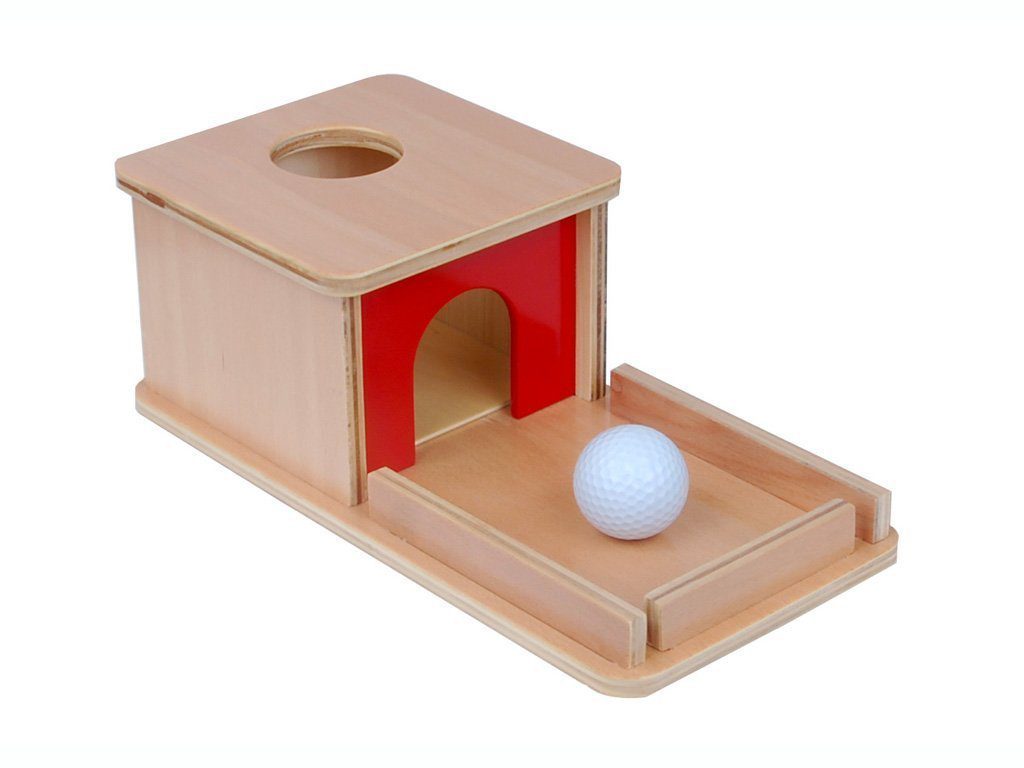
*At left is an example of the famous Montessori object permanence box. If you’ve tried making your own I’d love to see a picture!
*This very inexpensive geometric puzzle (click the link to see) is a great example of a self-correcting puzzle! I would probably prefer that it have knobs for grasping at Baby J’s current stage, but I love the price on this one!
*Wooden stackable rings. We have this one and J loves it! Right now, he’s mostly interested in chewing on them and chasing the rings. (The ones I linked to are 1/3 of their original price.)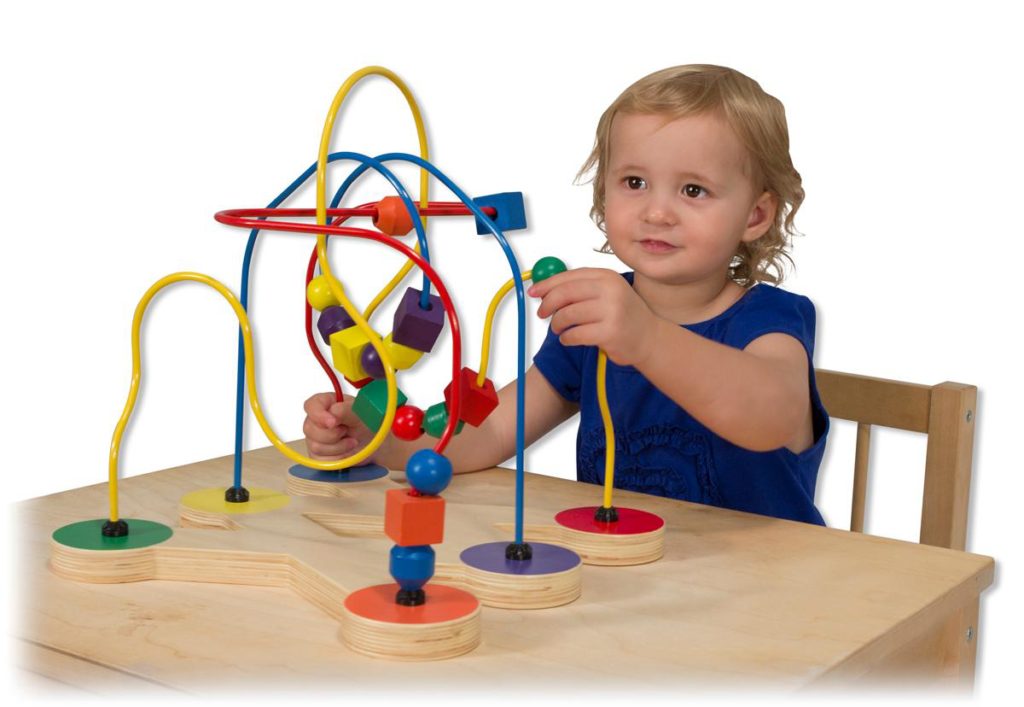
*Wooden Bead Maze. I loved these as a kid and could entertain myself with one for a long time. It turns out these things are excellent for developing fine motor skills! That must be why I can…thread a needle pretty well? 
For Sensory Play
*Textured Balls. Baby J’s grandma bought him these for Christmas, and he has had hours of enjoyment playing with them. He’s teething, so mostly he slobbers all over them. But sometimes we “play ball”–which means he accidentally lets it roll and I roll it back and he sticks it in his mouth. Repeat 30
times. He loves all the different textures, especially on the yellow one with knobs that stick out.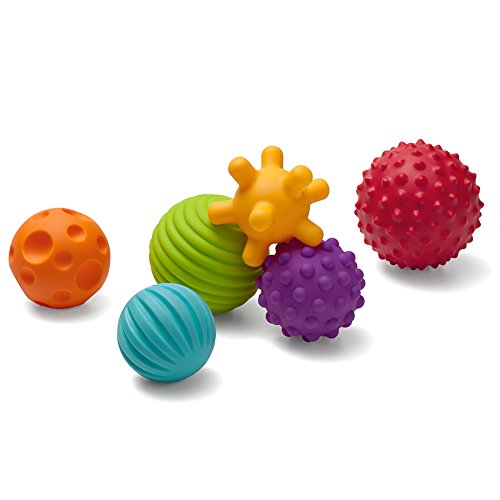
So what happens if your family members give your child a toy you aren’t crazy about?
Someone was asking me this question just a few days ago. Here are a few ideas, borrowed from my parents since I don’t have a child who’s old enough to have had much of this problem. (I also have the gift of parents/parents-in-law with very similar values.)
- Teach your child to show gratefulness. I remember my younger brother receiving a Christmas gift one year: boxing gloves that made loud shouting comments every time you punched with them. (Like, “Punch Me Again!”) He absolutely loved them, of course, but he knew my dad wouldn’t like them. So he looked up at Daddy and said loudly and importantly, “Just what we DIDN’T want, huh, Daddy?” Side note: children keep you humble because they constantly embarrass you. (We ended up letting our puppy play with the gloves at home. It was hilarious to watch him bat the gloves and step back in utter confusion.)
- Allow your child to play with it for a while (unless you have serious moral objections to the item in question).
- Go home and either set it aside (to be pulled out when the person visits) or let the child play with the toy for a while before giving it away. Perhaps you can allow him to choose where/with whom to share his new toy. (Goodwill?)
- Don’t become so legalistic about your toy choice that you aren’t okay with your child having fun. She loves the picture of the Little Mermaid that she got to color in the play group? Admire her color choices and how she stayed inside the lines.
Do I approve all the baby toys we have? Not necessarily, but some of them have been lifesavers for me when I just couldn’t get all my work done without having something to occupy the little guy. (Thank you, Lord, for that free ExerSaucer!) And you know what? That’s okay.


 : a favorite place to walk when we can!
Once
: a favorite place to walk when we can!
Once 
![The first photos are of my parents’ sprawling rural Arkansas garden. The last is of my tiny little beds in the big city. Plants bring life to even the smallest corner!
I’ve been reading some beautiful fiction this year, and I just posted a review of a book by one of my favorite authors, Leif Enger. (https://therestfulhome.com/brave-young-handsome-review/ in your browser, or click on the link in my Instagram profile) If you don’t have time to read the book, though, here’s just a quote or two for your enjoyment:
🎼
“Death arrived easy as the train; [he] just climbed aboard, like the capable traveler he was.”
🛤️
On riding a horse: “You are a feeble and tenuous being; the only thing a horse wants from you is your absence.” 🐎 😄
#quotes #leifenger #amreading #gardens #gardening](https://scontent-atl3-1.cdninstagram.com/v/t39.30808-6/468657020_18342474787176025_4442629541396867851_n.jpg?_nc_cat=108&ccb=1-7&_nc_sid=18de74&_nc_ohc=DEja6UP2ct4Q7kNvgEYJxCM&_nc_zt=23&_nc_ht=scontent-atl3-1.cdninstagram.com&edm=ANo9K5cEAAAA&_nc_gid=AA4bBsvQ_JpqZXLUPUTpTC8&oh=00_AYCjI9LUx-cJxe6cu0n7H1Gounaz92aBlTrQacnKut8umg&oe=67567CAB)

















Just purchased the Wooden Bear Stack toy for my 8month old grandson and he is delighted with it. It is a very colorful, sturdy product that sports the most inviting bear face. The day after I ordered the product the company sent an email stating it had shipped and… “We usually call him Theo (and sometimes ted) unless he’s naughty, then we call him Theodore!”
I thought that message was so cute, too!